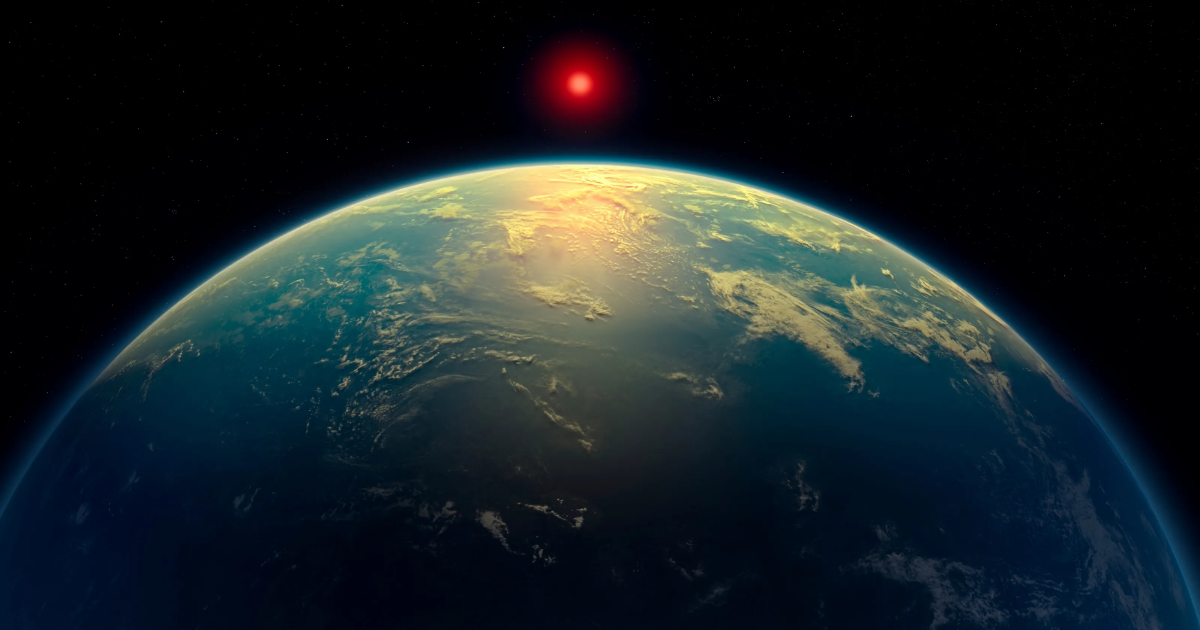The first sign of possible extraterrestrials detected in the cosmos didn’t come in the form of little green aliens flying around in saucer-shaped spacecraft.
In fact, the life that could be – emphasis on the could be – thriving on a distant ocean-covered planet named K2-18b is likely not intelligent at all.
But that doesn’t make the recent discovery any less exciting.
Astronomers at the University of Cambridge announced on April 17 that they had found the strongest evidence yet that life may exist anywhere else besides Earth. Using data from NASA’s James Webb Space Telescope, the researchers detected atmospheric clues hinting that microbial organisms could be living on the surface of K2-18b in the constellation Leo.
Here’s everything to know about the discovery, the intriguing exoplanet itself and the ongoing search for life in the cosmos.
Is there alien life on K2-18b?
A strong possibility exists that extraterrestrial life can be found on a distant exoplanet known as K2-18b.
Using observations from NASA’s James Webb Space Telescope, the researchers were able to find possible hints of molecules and gases that on Earth are signs of life.
But before you go picturing an advanced race of aliens, if anything is indeed living on the planet, it would likely be non-sentient microorganisms akin to Earth’s phytoplankton.
When is the Lyrid meteor shower? See peak days, cloud forecast when fireballs are active
What is an exoplanet?
Exoplanets are any planets that orbit stars outside of Earth’s own solar system. For that reason, these celestial bodies are sometimes also referred to as extrasolar planets.
Some, called rogue planets, don’t even orbit a star, but are rather floating through the cosmos untethered.
Astronomers have confirmed the existence of more than 5,800 exoplanets, but billions are thought to exist, according to NASA.
Why are astronomers interested in K2-18b?
K2-18b is considered a Hycean exoplanet – as opposed to a rocky planet – due to its potential to possess a hydrogen-rich atmosphere and surface covered in ocean water.
Since it was discovered in 2015, K2-18b, which orbits a red dwarf star more than 120 light-years from Earth, has captivated scientists who have considered it among the best potential life-harboring ocean worlds.
The first observations in 2019 confirming the possible presence of water were made with the Hubble Space Telescope.
In September 2023, another investigation with Webb – an advanced telescope launched in 2021 outfitted with powerful infrared instruments – revealed something more: traces of carbon-bearing molecules in K2-18b’s atmosphere, including methane and carbon dioxide.
What is a ‘habitable zone?’
These conditions classify the exoplanet as being in what astronomers refer to as the habitable zone – where planets have the right conditions for water, providing a key ingredient for life to flourish.
In a nod to the classic fairy tale, astronomers even refer to planets with these conditions as “Goldilocks” zones because conditions have to be just right – neither too hot nor too cold – for water to remain in liquid form and pool on surfaces.
How big is exoplanet K2-18b?
K2-18b is a whopping 8.6 times bigger than Earth.
The planet’s large size – with a radius 2.6 times that of Earth – means that the planet’s interior likely contains a large mantle of high-pressure ice, like Neptune, according to astronomers.
K2-18b is also smaller than Neptune, making it what astronomers refers to as a “sub-Neptune” planet that, while not present in our solar system, is what NASA says is among “the most common type of planet known so far in the galaxy.”
How did astronomers make the recent discovery?
For the most recent discovery, a team of researchers used a different instrument outfitted to Webb to study the light from K2-18b’s parent star as the planet passed in front of it from Earth’s vantage.
As starlight passed through the planet’s atmosphere, the clues left behind allowed for astronomers to piece together the gases in the atmosphere and detect a possible biosignature. On Earth, the sulfur-based gases they detected are only produced by life, primarily microbial life.
The observations could have occurred by chance or could be the result of previously unknown chemical processes at work on K2-18b, according to the researchers. For that reason, the team hopes to make follow-up analysis with Webb to reach a more definitive conclusion.
Where else are astronomers searching for life?
In our solar system, Earth is one of only three planets, along with Mars and Venus, that fall within the habitable zone.
On Mars, two of NASA’s robotic rovers are in the process of searching the now-barren planet for clues that life could ever have existed on its surface.
As of October, NASA has also sent its uncrewed Europa Clipper spacecraft on a far-reaching journey to one of Jupiter’s many moons where water is believed to exist beneath an icy surface. Once the orbiter reaches the icy moon Europa in 2030, it will begin scouring the surface from above to look for signs that life could thrive.
Otherwise, NASA, the world’s space agencies and other astronomers believe the best opportunity to discover life beyond Earth may exist outside our solar system.
The Milky Way galaxy is likely teeming with trillions of planets, many of which are similar in size to Earth and orbit within their stars’ habitable zones. While no conclusive evidence has yet been found of extraterrestrial life, scientists are seeking out worlds like K2-18b with hydrogen-rich atmospheres that astronomers believe to be covered in liquid water.
And it’s not just government space agencies like NASA that are avidly involved in that work.
Organizations like the SETI Institute are similarly dedicated to exploring the cosmos for extraterrestrial neighbors. SETI (Search for Extraterrestrial Intelligence) even last year harnessed technology to expand its search beyond our own galaxy.
Eric Lagatta covers breaking and trending news for USA TODAY. Reach him at [email protected]
